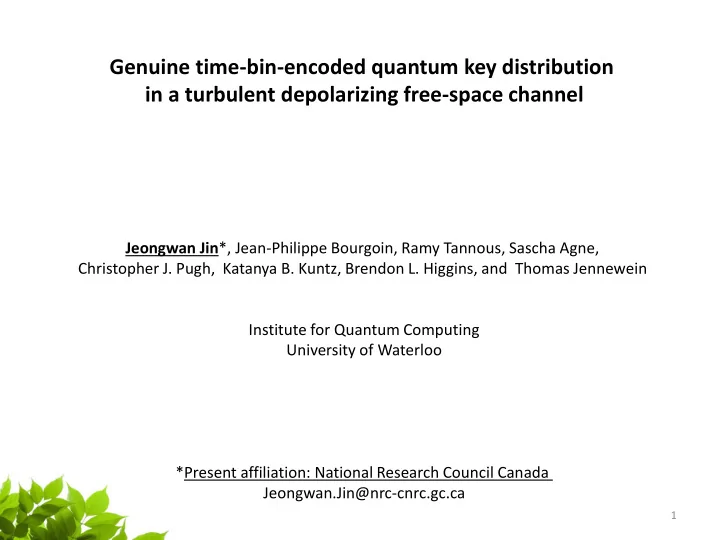

Genuine time-bin-encoded quantum key distribution in a turbulent depolarizing free-space channel Jeongwan Jin *, Jean-Philippe Bourgoin, Ramy Tannous, Sascha Agne, Christopher J. Pugh, Katanya B. Kuntz, Brendon L. Higgins, and Thomas Jennewein Institute for Quantum Computing University of Waterloo *Present affiliation: National Research Council Canada Jeongwan.Jin@nrc-cnrc.gc.ca 1
Outline 1. Time-bin encoding for free-space quantum communication : motivations and challenges 2. Quantum key distribution demonstration 2-1. in a turbulent free-space channel 2-2. in a depolarizing and turbulent free-space channel 3. Summary and outlook 2
Time-bin encoding: versatile for quantum communication in optical fibres Conventional passive time-bin quantum-bit analyzer middle-bin late-bin early-bin 50/50 BS 50/50 BS Interference is crucial for time-bin state analysis ! I. Marcikic et al ., Nature 421 , 509 (2003) Commercial QKD system 1 Fibre-memory storage 2 City-wide teleportation 3 Boson sampling 4 1. Idquantique.com 2. Quantum storage of entangled telecom-wavelength photons in an erbium-doped optical fibre, E. Saglamyurek, et al. Nat. Photon. 9, 83 (2015) 3. Quantum teleportation across a metropolitan fibre network, R. Valivarthi et al., Nat. Photon. 10 , 676 (2016) 3 4. Time-bin-encoded boson sampling with a single-photon device, Y. He et al., Phys. Rev. Lett. 118 , 190501 (2017)
Time-bin encoding: challenges for free-space quantum communication 1 Beam Wandering ΔT=2ns Interference visibility Angle of Incidence Error = 0.06 o J. P. Bourgoin et al., Opt. Express 23, 33437 (2015) Angle of incidence (degree) Wavefront Distortion ΔT=2ns Interference visibility D. L. Fried et al., App. Opt. 31, 2865 (1992) Angle of incidence (degree) 1. Demonstration of analyzers for multimode photonic time-bin qubits, J. Jin et al., arXiv:1509.17490 (2015); Phys. Rev. A 97 , 043847 (2018) 4
Time-bin encoding: recent progress towards free-space quantum communication Prior solutions : single-mode-fibre filtering (high loss) / adaptive optics (expensive, challenging) Method 1: Imaging optics D. J. Erskine, US patent 6115121 (1997) ΔT=2.0ns ΔT=0.57ns Method 2: Different refractive index R. L. Hillard et al., JOSA 56 , 362 (1966) MM-TQA MMF SMF Entanglement preserved J. Jin et al., arXiv:1509.17490 (2015); F. Steinlechner et al., G. Vallone et al., C. Zeithler et al., 5 Phys. Rev. A 97 , 043847 (2018) Nat. Commun . 8 , 15971(2017) Phys. Rev. Lett. 116 , 253601(2016) Proc. of SPIE 9739, 973912 (2016)
Quantum key distribution: decoy-state BB84 protocol 1-3 Alice Bob 2 ns passive 1870 propagation modes 4 Classical Postprocessing 01001 01001 00110 00110 1. Quantum cryptography, C. H. Bennet and G. Brassard, Proc. of IEEE Int. Conf. on Computers, Systems and Signal Processing 175 , 8 (1984) 2. Quantum key distribution with high loss: toward global secure communication, W. – Y. Hwang, Phys. Rev. Lett. 91 , 057901 (2003) 3. Practical decoy state for quantum key distribution, X. Ma et al., Phys. Rev. Lett. 72 , 012326 (2005) 4. Focusing and scanning light through a multimode optical fiber using digital phase conjugation, I. N. Papadopoulos et al, Opt. Express 20 , 10583 (2012) 6
Quantum key distribution: key component – multimode time-bin qubit analyzer Input Output + Output - Passive compensation Interference visibility = up to 97 % Throughput = 81 % from input to output coupling Minimized dispersion 7
Quantum key distribution: setup 1 1. J. Jin et al., paper in preparation 8
Quantum key distribution: setup photos 1 Alice Bob 1. J. Jin et al., paper in preparation 9
Quantum key distribution: in a turbulent free-space channel 1 Mean Coherence Length = 7.83 cm Mean Time-Bin QBER = 5.23 % Secret Key Rate = 178.9 bits/s 1. J. Jin et al., paper in preparation 10
Quantum key distribution: in a depolarizing and turbulent free-space channel 1 Mean Time-Bin QBER = 4.99 % Secret Key Rate = 167.2 bits/s 1. J. Jin et al., paper in preparation 11
Summary 1. Time-bin encoding viable for QKD in a turbulent depolarizing free-space channel 2. Passive multimode time-bin analyzer with - high throughput of 81 % from input to output coupling - stable interference visibility up to 97 % Outlook 1. Time-bin QKD over multi-mode optical fibre 2. Implementation of COW- and DPS-QKD protocols in free space 3. Direct interfacing between fibre and free-space quantum network links 4. Polarizing effects of optics (e.g. lens and mirror) and optical path can be overcome 12
Recommend
More recommend